Partisan artillery. RPG-7 in local armed conflicts
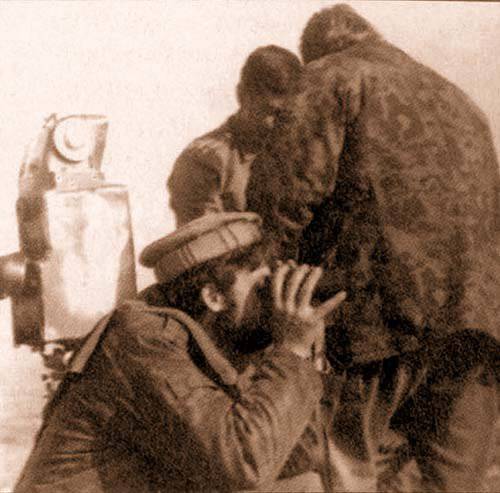
Along with the Kalashnikov assault rifle, which is well-known all over the world, it is no less popular, referring to another type. weapons, hand-held anti-tank grenade launcher RPG-7. The wide geography of its combat use in the Near and Middle East, the African continent, in Southeast Asia, Latin America indicates the reliability of this grenade launcher in any geographic zone. It is reliable in the jungle, highland, mountain-desert and desert areas - in conditions of significant influence of adverse environmental factors. Adopted by the Armed Forces of the USSR in the 1961 year, it is used in the armed forces of more than 40 states, and in some countries its mass production has been established.
The design of the RPG-7 is so simple and reliable that since its mass production only used ammunition has been improved. Domestic industry produces only anti-tank cumulative grenades PG-7В, PG-7ВМ, PG-7ВЛ, PG-7ВР (combat unit of tandem type). But there are fragmentation grenades (above-caliber and caliber) of Arabic and Chinese manufacture.
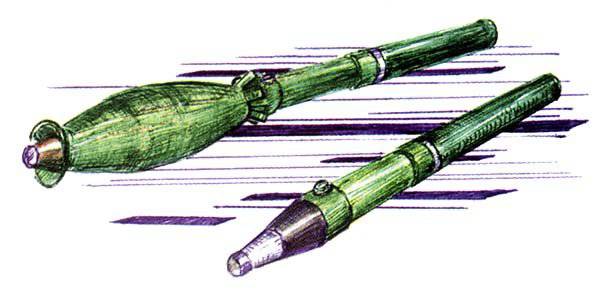
As the most acceptable anti-tank weapon for the majority of illegal armed groups (irregular armed formations), RPG-7 in the context of local military conflicts had a significant impact on the development of their tactics. Moreover, in Afghanistan and other hot spots, where the formation of the AMF - All Mojahedeen Force (the United Mojahedin Force) is involved in the armed conflict, has accumulated vast experience and a clear system of its combat use has been developed.
With the introduction of Soviet troops into Afghanistan in December 1979, the opposition’s armed forces had to face a significant number of armored vehicles - especially armored personnel carriers and infantry fighting vehicles, opposing only a small number of anti-tank weapons. Considering the organizational structure of various groups, detachments and fronts of the armed Afghan opposition from 1979 to 1989, it is easy to detect a tendency to increase the saturation of formations with grenade launchers. So, in 1983 – 1985, one grenade launcher fell on 10 – 12 fighters, and by 1987, the same number of personnel already had two RPG-7 grenade launchers.
Separate anti-tank and special groups armed RPGs based on 50 – 80% of personnel and totaled up to 15 grenade launchers. In the face of a shortage of artillery or the impossibility of its use, an additional task was assigned to the RPG-7 for “artillery” support of military operations, which in some episodes of the battle was carried out more efficiently than by artillery fire. This explains the fact that in the infantry department of the Iranian Armed Forces (11 people) since the war with Iraq, there are two RPG-7 in service.
When conducting a battle in a closed area (mountains, forest, jungle, settlements), the warring parties, as a rule, separate only a few tens of meters. In such conditions when artillery fire and aviation It also poses a threat to its troops, RPGs become an indispensable firearm, and the presence of an optical sight makes firing from it particularly accurate and safe for their units.
The Vietnamese called the tactic of tying the enemy with a melee attack by the term “grabbing the belt”; the Afghan Mujahideen used it everywhere, especially effectively and often in the “green zone” and high mountains. Thanks to similar tactics in both cases, the enemy (American and Soviet troops, respectively) lost their main advantage - artillery and aviation fire. Ignorance and ignoring of this tactic led to the decision not to include grenade launchers (RPG-7, RPG-16) in the staff of the special forces OXV troops in the RA (limited contingent of Soviet troops in the Republic of Afghanistan).
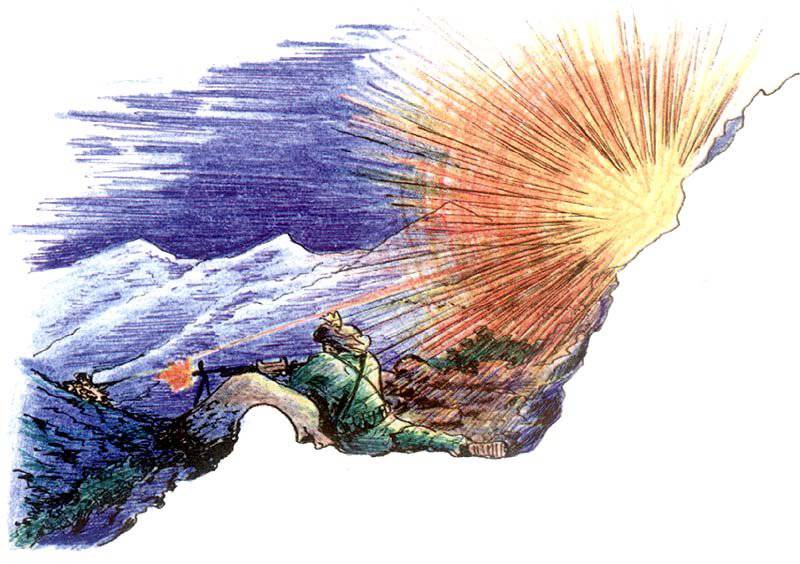
Their absence was partly compensated for by the presence in the companies of special forces of flame-throwers armed with RPO-A “Bumblebee” - highly effective in combat capabilities, but too heavy for autonomous actions of special forces groups in the mountains, as well as the use of RPG-18 and RPN-22 rocket grenades.
I would like to recall the 53-mm RPG-16 “Strike” (sighting range - 800 meters), which was in the 1970-80-ies in service of the airborne units of the Soviet Army and is considered unjustly removed from service. I personally managed to arm my special forces group with non-standard RPN-16 in the company and effectively use it in 1985 – 1987 during the fighting in the provinces of Nangarhar, Kunar, Laghman (eastern Afghanistan). Moreover, a small trick was used to suppress the firing points of the Mujahideen in the high mountains - firing is somewhat higher than the shelters located on the slopes of the mountains, taking into account the defeat of the enemy by shrapnel and a blast wave of a torn grenade. By the way, many divisions of OKSV in RA widely used captured RPG-7 Chinese (“Type 69”), as well as Arab production, lighter than domestic ones, equipped with bipod and carrying handle.
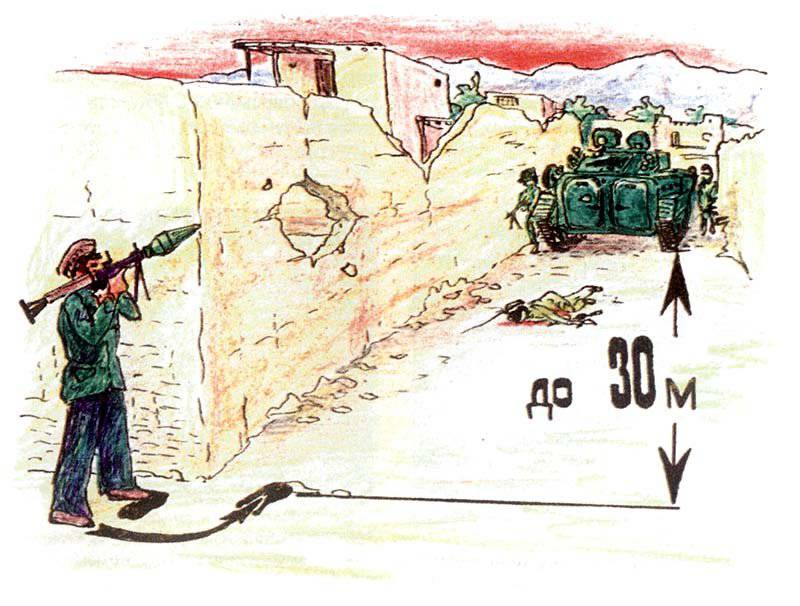
The widespread use of the Afghan Mujahideen RPG-7 inevitably led to an increase in losses in the personnel of the SSNV from the fire of grenade launchers, including on foot operations. For example, 13.03.87 in the province of Laghman, Alishang village, an 7 man was injured by an anti-tank grenade launcher when a mortally wounded group commander, 4.09.87 in the Kunar province, was hit by two RPG grenades into the flat roof of the house (shooting was conducted from above) 11 people inside the house received fragmental wounds and contusions.
Fire from an anti-tank grenade launcher in openly located manpower with the use of cumulative ammunition gives a satisfactory result of destruction by shrapnel and a blast wave of personnel in a radius of up to 4 meters and has an additional demoralizing effect. An example of achieving a high mental effect from the massive use of RPG-7 fire in terms of manpower can be considered the fall of the so-called “Panj Front” (Tajikistan), when during the release of November 22 1992 by armed detachments of the Tajik opposition together with the Afghan Mujahideen of the Pyanj-Kurgan-Tyube highway for each shot of small arms from the opposite side, an 2 – 3 shot from an RPG (in most cases unimportant) followed.
Speaking of massaging RPG fire, we should mention the special groups of grenade launchers that I first encountered in Tajikistan in the autumn of the 1992 year (similar groups were used in both Afghanistan and Chechnya). In Tajikistan, the so-called “Namangan” group of 25 – 30 religious fanatics had a man armed with RPG-12 grenade launchers and RPG-7 and RPG-18 rocket launchers before 26.
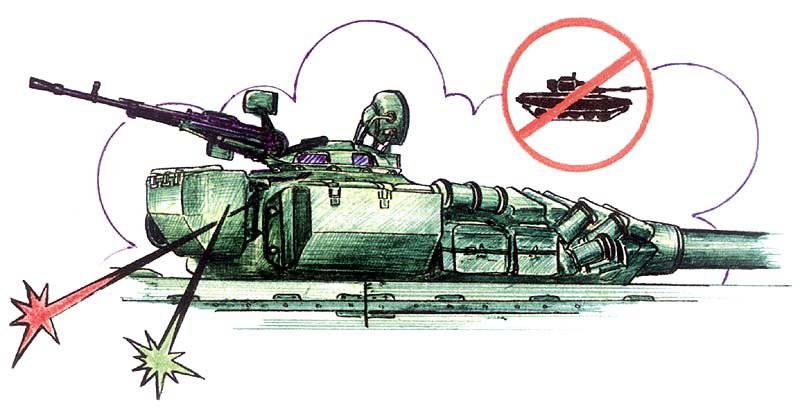
The peculiarity of the group’s tactics was the destruction of armored vehicles of the People’s Front of Tajikistan by consistently concentrating fire on two or three RPGs on one armored vehicle from 20 – 50 meters, and faced with T-72 tanks equipped with elements of dynamic protection (DZ), the first rocket launcher (operated in pairs ) shot down a DZ, and the second hit the tank in the unprotected part of the armor. The nature of the defeat of the tanks indicated that firing, apart from cumulative grenades, was also carried out by fragmentation, in the frontal part, for disabling optical observation devices (sights) with the aim of "blinding" the crew.
By firing at a very close distance, the grenade launcher, with reliable fire cover from the enemy infantry, is capable of producing an accurate aimed shot at the most vulnerable point of the armored object. This explains the defeat of T-72 tanks in Tajikistan to the rear of the tower after knocking out a box with property with a first shot, hitting a cumulative cannon jet, a direct hit by a fragmentation grenade into the driver’s observation device (determined from the fuse remains in triplex glass), followed by a defeat fragments of devices located on the tower.
In all cases of defeat of the T-72 tank from a hand-held grenade launcher, the crews remained intact, except for the case of a grenade hitting the rear of the tower (gunner and tank commander were seriously injured), but the tanks were removed from the battlefield, as they needed to be restored. RPG-7 for modern tanks, and with the advent of the PG-7BP "Resume" grenade with a tandem type warhead, all modern types of armored vehicles can be reliably hit.
With the defeat of the armored vehicle by a cumulative grenade, the factors affecting the crew are excessive pressure, fragments of armor and a cumulative jet. But taking into account the adoption by the crew of measures precluding the formation of excessive pressure inside the machine, such as the opening of hatches and loopholes, fragments of armor and a cumulative jet remain the factors affecting personnel. On a person, the striking effect of the cumulative jet inside the armored vehicle is at a distance of up to two and a half meters, and fragments - for the entire length of the internal space.
Good protection against RPG fire with conventional cumulative ammunition (PG-7В type grenades, PG-7ВЛ) on modern armored vehicles provide spaced booking, anti-cumulative screens and dynamic protection elements. That is why it is necessary to concentrate the fire of several RPGs and other anti-tank weapons on one armored vehicle in order to defeat it reliably, which is confirmed by the tactics of actions of the AMF formations during the local armed conflicts of recent decades.
In most cases, the intensive firing of automatic small arms by an assistant grenade launcher and other shooters contributes to accurate RPG firing in order to force enemy infantry to stop monitoring the battlefield and aimed fire, as well as to destroy the optical sights of enemy combat vehicles. This allows the grenade launcher without too much fuss, and less likely to be hit, to take a favorable firing position, determine the aiming point, and after the shot quickly and imperceptibly change firing position.
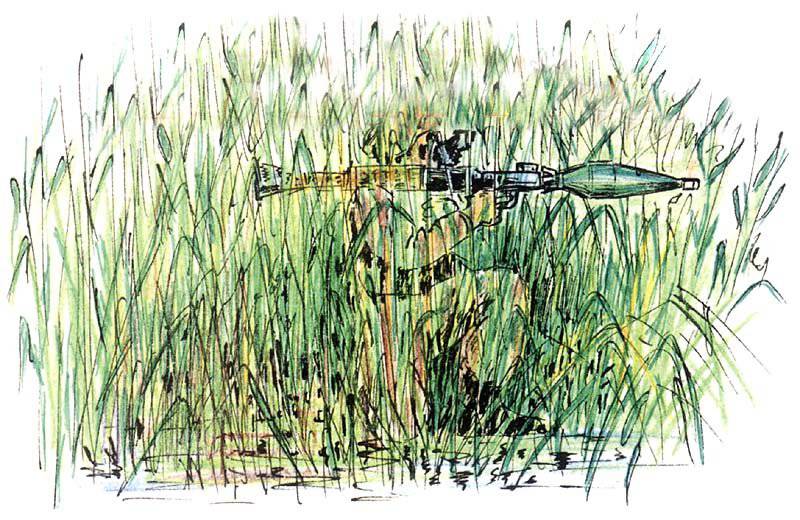
When firing at one target of two or three RPGs, shooting is sometimes performed without a mandatory change after each firing position shot, especially if the target is hit by the first shots. Very often in such situations, rocket launchers enter into unhealthy excitement and, forgetting about the precautionary measures, pay dearly for it. For example, the “Namangan” group during October-December 1992 of the year was completely destroyed by the price of two burned-down BTR-70, as well as three damaged T-72 and one BTR-80.
When arranging ambushes, one of the main methods of conducting combat operations of irregular formations, to reduce dusting and unmasking a firing position at the moment of firing from an RPG and other jet weapons, the choice of advantageous firing position is very important. With time and conditions, it was usually specially prepared - the ground was watered. The firing position of a grenade launcher is well massed by thickets of high bushes, reeds, corn crops and other grassy plants over two meters high. It should be remembered that in the direction of shooting there should be no vegetation that impedes the flight of grenades (in order to prevent the grenade from detonating when grazing branches and grass, the safety cap is not removed from the fuse).
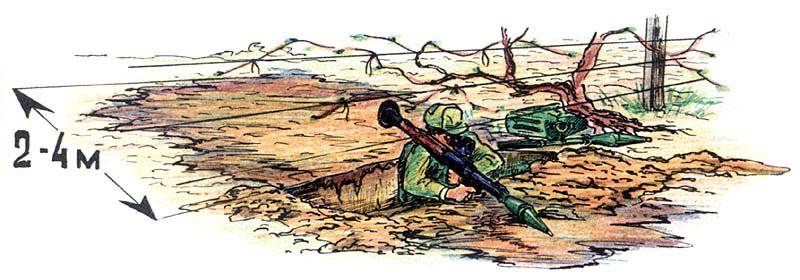
Despite the observance of measures to reduce dust formation, the firing position of the grenade launcher at the time of the shot is unmasked by a characteristic flash and white-gray smoke. If you are on the battlefield from the opposite side noticed such a flash, then the most rational action of yours will be a warning shout “flash” (“lie down”, “shot”) provided that the co-workers know what to do with this command - lie down on the ground (for shelter) and cover the ears with your hands.
In my practice there was a case when noticing an 350 – 400 meter flash RPG-7 shot from a distance of 4, I gave the command to “lie down” to a nearby subordinate and a grenade exploded in the XNUMX-meters (on a level platform) did not harm anyone. But the grenade launcher was not lucky, he never did the second shot, since he “forgot” to change the firing position ...
A serious threat to the RPG-7 fire is for helicopters, especially at the time of landing personnel and cargo by landing method, evacuation of the wounded and other cases related to landing on the territory controlled by the enemy. In January, 1986, two of the six helicopters parachuting personnel, during a raid by a special unit on the fortified area "Command" north of the city of Jalalabad (Afghanistan) were damaged by RPG-7 fire. Because of the density of the fire, the entire detachment failed to land, since, in addition to the two helicopters damaged at the time of landing, the fire from the RPG was conducted along airplanes.
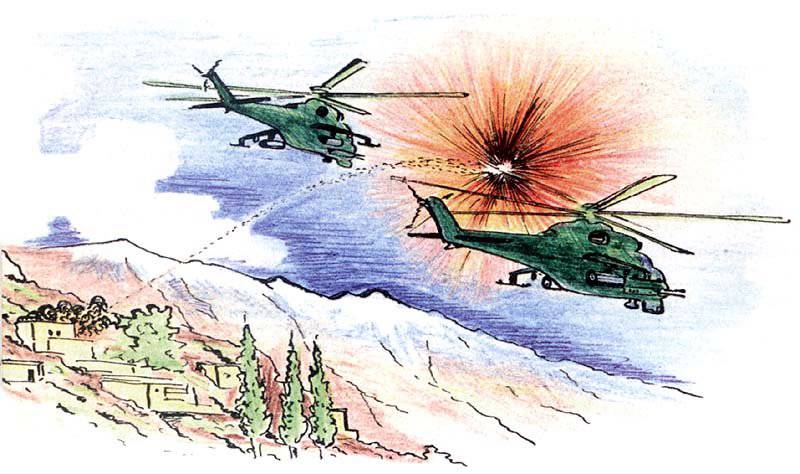
In a flying RPG helicopter, it is effective only in frontal firing from a distance of up to 100 meters, as well as when firing at the range of the self-killer of a cumulative grenade - 700 – 800 meters. The latter type of fire, despite the low probability of hitting the helicopter, still represents a danger to it and forces the crew to take additional precautions. Including a great height, which in all cases eliminates the surprise factor when helicopter fire strikes and landing of personnel, makes it difficult to conduct aerial reconnaissance. Moreover, the explosions in the air from the PG-7 grenade self-destructor and the rocket of the portable anti-aircraft missile system are identical in appearance, which makes it difficult for the crew to choose the right solution for the helicopter crews (pilots of attack aircraft) and the commanders of the units operating on the ground.
Another non-standard method of firing an RPG-7 anti-tank grenade launcher in local conflicts is a mounted trajectory fire using both fragmentation and cumulative grenades. With the exception of the use of fragmentation grenades, it is not as effective as direct fire, and is used mainly to conduct disturbing fire at area targets. The “nuisance” of this type of shooting, like during a mortar attack, is the difficulty of determining the firing position of the grenade launcher, especially in closed areas.
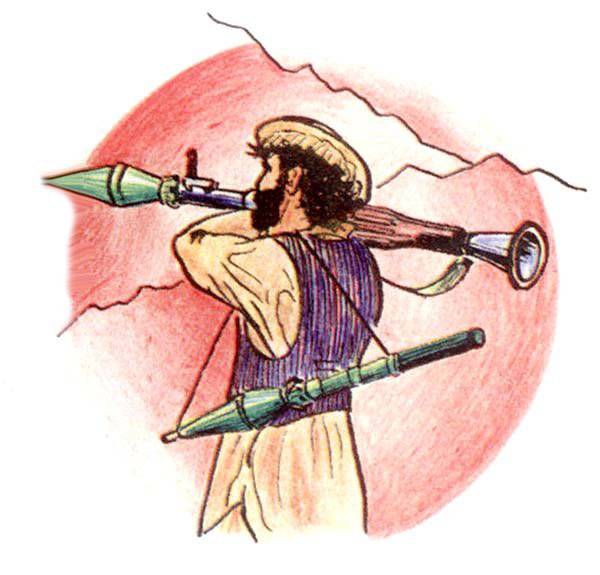
Between specialists, the disputes about the amount of portable ammunition for the RPG-7 do not abate. The set of the grenade launcher includes two bags for carrying shots for two and three grenades for the arrow-grenade launcher and his assistant, respectively, which means that there are five shots in the ammunition. I believe that it is this amount that is the golden mean that should be taken as a basis for conducting a military operation.
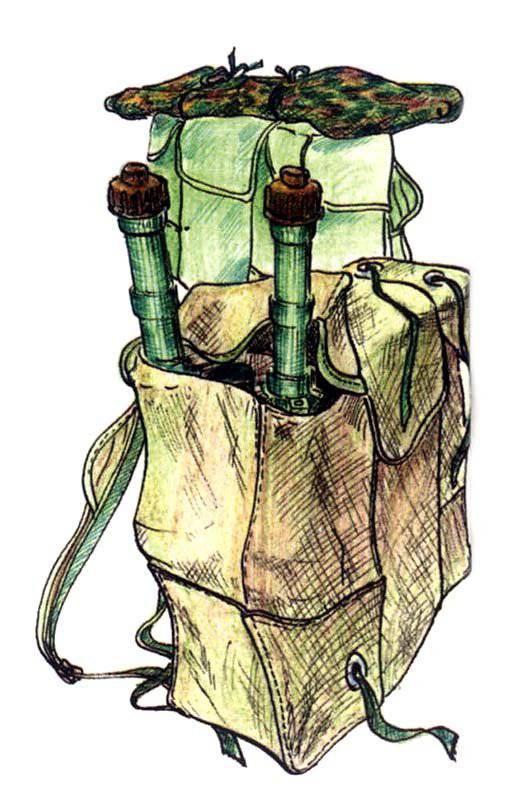
The Afghan mojahedin observed that only rarely did one grenade launcher use more than two or three grenades in combat, preferring to wear one in the barrel and the other on the shoulder using gadgets from a rope belt (this was the way grenades were carried by the grenade mate or ammunition carriers).
The method of carrying grenades on a belt is unsuitable in areas with a humid climate, since the paper insulation of the powder charge is easily damaged, which leads to a deterioration in firing accuracy due to dampness of the powder, and most often to a complete unsuitability of the powder charge. Portable bags for shots from Afghans were not popular, and we preferred another “container”.
Using RPG-7 and RPN-16 in Afghanistan as a reinforcement of special forces groups, wearable ammunition for grenade launchers consisted of 6 – 12 shots, depending on the conditions of the combat mission, and, following the example of the Mujahideen, the grenade launchers were always pre-loaded, and for carrying the shots used more acceptable amphibious backpacks RD-54, grenades in which were carried in the side pockets head down. Sometimes, for masking, the shots were placed in pairs in fabric covers specially made for this purpose (cropped sleeves or leg of an old field uniform) and fastened to backpacks with ties.
After all that has been said about the veteran grenade launcher, it remains only to lament that the lack of fragmentation, incendiary smoke, lighting and other special ammunition remains a significant drawback of the Russian RPG-7. They would significantly expand the range of capabilities of the units of the Russian Army.
Information